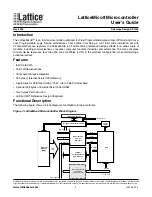DEBUG MODE
Debug Mode supports application development and debug. Debug mode is available to the
user through the factory loaded serial monitor, integrated USB-BDM on the PBMCUSLK or an
external HC(S)12 BDM cable. Refer to the PBMCUSLK User Guide for details on using the
integrated USB-BDM.
The steps below describe the steps to put a device in debug mode using the serial cable OR
BDM options.
1. Install and launch the latest CodeWarrior Development Studio.
2. Configure Application specific components. Set jumpers, connect auxiliary equipment to
the module, connect COM port, and launch supporting host communication software, as
needed by the application.
A DB9 serial communications (COM) cable supports the use of serial programming. The steps
below describe using a serial DB9 cable with CodeWarrior for programming and debug.
i.
Power-On the device.
ii.
Connect COM port serial communication cable between application module and host
PC.
iii.
Press and hold simultaneously SW1 and RESET push buttons.
iv.
Continue holding SW1 while releasing RESET. Wait 3 seconds, and then release
SW1. The serial monitor is now waiting for the development software to establish
DEBUG communication.
v.
Verify that your CodeWarrior debug target is HCS12Serial Monitor.
A 6-pin BDM interface header (BDM_PORT) supports the use of an external HC(S)12 BDM
cable. The steps below describe using an external HC(S)12 BDM cable to access DEBUG
mode.
i.
Connect the HC(S)12 BDM cable to the BDM_PORT header.
ii.
Connect the supplied USB cable between an available USB port on the host PC and
the USB connector on the board.
iii.
Verify that your CodeWarrior debug target is “P&E MultiLink/Cyclone”
(or as required
by your hardware selection).
3. Compile project and execute debugger in CodeWarrior. The development software will
establish the DEBUG communication.
NOTE
Upon hardware RESET, the device will default to RUN mode. You will need to do parts of the
above steps to get the hardware back in to DEBUG mode.
8 Freescale Semiconductor


















